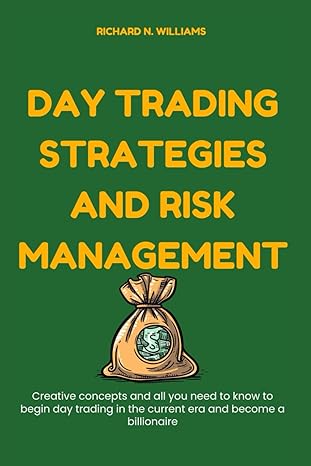Question
Problem Set 4 To get the full credit, you would need to cover Q1, Q2 (a, b, c and d) and Q3. To get the
Problem Set 4
To get the full credit, you would need to cover Q1, Q2 (a, b, c and d) and Q3. To get the half credit, you would need to cover either Q1 or Q2 (a, b, c and d) and Q3.
Q1 (Essential to cover)
The risk free rate is 5% and the following data is given about assets X and Z:
Asset E(r)
X 9.5% 18%
Z 12% 20%
(a) What are the Sharpe ratios of the two risky assets?
(b) Show how you can dominate asset X using a portfolio that combines asset Z and the risk free asset.
(c) Show how you can dominate a portfolio with equal weights in asset X and the risk-free asset using a portfolio that combines asset Z and the risk-free asset.
(d) Show (in general) how you can dominate any portfolio combining asset X and the risk-free asset using a portfolio that combines asset Z and the risk-free asset.
Hint: by general, I mean you assume any general fraction (like ) of wealth in asset X. And
then show how to design a portfolio combining asset Z (with the fraction of wealth in asset Z)
and the risk-free asset which will dominate the portfolio of asset X and the risk-free rate. So
essentially you will need to show the relationship between of the DOMINATING portfolio and
of the DOMINATED portfolio.
Q2 (Essential to cover a, b, c, d)
Suppose that the risk-free rate is 4% and that the corresponding optimal risky portfolio has an expected return of 16% and a standard deviation of 20%. Consider an investor with preferences represented by the utility function U = E(r) 0.5A2, where A = 2.5.
(a) What fraction of her wealth should she invest in the risky portfolio?
(b) Should she invest more or less fraction of her wealth in the optimal risky portfolio if she is more risk-averse? Why?
(c) Should she invest more or less fraction of her wealth in the optimal risky portfolio if the optimal risky portfolio offers a higher expected return (but the same standard deviation)? Why?
(d) If the risk-free rate is higher, what would you expect the optimal risky portfolio to differ from the current one (for 4% risk-free rate) in terms of expected return and standard deviation?
(e) Now suppose that the investor faces a higher risk-free rate when borrowing (because you are facing more borrowing constraints than the government, or people wont allow you to borrow at the same rate as the government). Specifically, the investor may lend at a risk-free rate of 4% but has to borrow at a risk-free rate of 5%. Assume for simplicity that the optimal risky portfolio is the same for either 4% risk-free rate or 5% risk-free rate, i.e., with an expected return of 16% and a standard deviation of 20% (this should not be the case in reality, as you will find out in question (d)). What fraction of her wealth should the investor now put in the risky portfolio?
Hint: The risk-free rate of 4% will imply a fraction 1 of wealth invested in the optimal risky portfolio. The risk-free rate of 5% will imply another fraction 2 of wealth invested in the optimal risky portfolio. However, 4% is only available for the investor to lend (so she cannot borrow to invest more than her wealth to invest in the optimal risky portfolio). If she wants to borrow to invest more than her wealth to invest in the optimal risky portfolio, she will have to go with 5% risk-free rate (but she wont be able to lend at 5% rate).
The key here is: you would need to understand what weights in the optimal risky portfolio mean she will lend, and what weights mean she will borrow.
(f) What is the expected return and standard deviation of the portfolio that you found in (e)?
Q3 (Essential to cover) The optimal risky portfolio P* has an expected return of 12.5% and a standard deviation of 25%. The current risk-free rate in the market is 2.0%.
a. Draw the capital allocation line. What is the slope of this line and what does it represent?
Suppose that separation theorem holds, and all investors invest along a common capital allocation line. Consider two different investors. Aggressive investor A holds an optimal complete portfolio which has a standard deviation of 28%. Conservative investor C holds an optimal complete portfolio with a standard deviation of 15%.
-
What is the Sharpe Ratio of Investor A and Investor Cs optimal complete portfolio?
-
What is the expected return of Investor A and Investor Cs optimal complete portfolio?
-
What is allocation to risky assets y* for Investor A and Investor Cs optimal complete portfolio?
-
Derive the implied risk aversion coefficient for Investor A and Investor C.
-
Explain why these results are a demonstration of separation theorem.
Selected end-of-chapter questions (Optional) BKM chapter 6: Q1-3, Q21 BKM chapter 7: Q16
Step by Step Solution
There are 3 Steps involved in it
Step: 1

Get Instant Access to Expert-Tailored Solutions
See step-by-step solutions with expert insights and AI powered tools for academic success
Step: 2

Step: 3

Ace Your Homework with AI
Get the answers you need in no time with our AI-driven, step-by-step assistance
Get Started


